2018 Jeep Wrangler JL Review and First Drive


Jeep has something special with the Wrangler, and the brand knows it. Every carmaker dreams of having the drove of dedicated, passionate fans that Jeep has. These folks love the Wrangler for its off-road capability, unique style, and breadth of available aftermarket accessories and parts.
So how do you redesign an icon without angering the faithful people who are so invested in the product?
In the case of the new 2018 Jeep Wrangler, the “JL” generation, FCA has made a ton of little changes with an eye toward adding comfort and convenience, but the big things — the things that make a Jeep a Jeep — remain the same. The Wrangler still looks like a Wrangler and it’s still good off-road. The real question is this: Did Jeep manage to make the Wrangler handle better on the pavement? Before we get to that, let’s look at all the new features that Jeep added to modernize its old-school off-roader.
FAST FACTS
| Engines: | 3.6L V6/2.0L turbo 4-cylinder |
| Output: | 285 hp, 260 lb-ft/270 hp, 295 lb-ft |
| Transmission: | 6-speed manual (3.6L only) or 8-speed auto |
| US Fuel Economy (MPG for 3.6L auto): | 18 city, 23 highway, 20 combined. |
| CAN Fuel Economy (L/100 km): | Not yet available |
| US Price: | Starts at $26,995 |
| CAN Price: | N/A |

Powertrain Breakdown
Three powertrains will be available under the hood of the Wrangler. The base option is the same 3.6-liter Pentastar V6 found in the Wrangler today, still making 285 horsepower and 260 pound-feet of torque, hooked up to either a six-speed manual or an eight-speed automatic. If you would like to row your own gears, the V6 is your only option, as the other two engines will only be hooked to the eight-speed.
Get the Flash Player to see this player.
The upgraded option for Wrangler buyers is a 2.0-liter turbocharged four-cylinder engine making 270 hp and 295 lb-ft of torque. The most important part of this engine isn’t the higher torque number than the V6, but the fact that all that torque is made at 3000 rpm as compared to 4800 in the naturally aspirated engine.

Also helping with some low-end boost is Jeep’s new eTorque system, a 48-volt mild hybrid setup that regulates the auto stop/start system, electric power assist, extended fuel shut-off, transmission shift management, intelligent battery charging, and regenerative braking. The eTorque system also makes it possible for the Wrangler to shut off both the engine and fuel flow during stops or when coasting or decelerating.
ALSO SEE: Jeep to Introduce Plug-In Hybrid Wrangler for 2020 Model Year
The third and final engine is the 3.0-liter EcoDiesel, which can only be had in Wrangler four-door models and will become available starting in 2019. Power from the diesel is rated at 260 hp and 442 lb-ft of torque.
Fuel Economy and Weight
Opting for the diesel will no doubt be a boon for fuel economy, but Jeep did a lot with the Wrangler all over to help it burn less fuel. First, almost all of the design changes that were made are in the name of fuel economy, such as the sharper rake on the windshield and the slant included at the top of the grille.

Besides increasing how aerodynamic the Wrangler is, Jeep also cut weight by about 200 pounds on most models by using aluminum in the doors, window frame, hood and swing gate.
A basic two-door Wrangler Sport with a manual transmission tips the scales at 3,955 lbs, while the heaviest model, a four-door Wrangler Sahara with the 2.0-liter turbo, weighs in at 4,380 lbs.
Fuel economy has only been rated by the EPA for the 3.6-liter four-door model, which managed 18 mpg city, 23 on the highway, and 20 combined with the automatic.
If improved fuel economy was a priority for the new Wrangler, better on-road driving dynamics were an absolute must for the new Jeep and the brand delivered.

No-Wander Cruising
No longer is driving the Wrangler a fatiguing experience, which is probably the biggest change that has come to the driving experience in the JL. This new generation stays nice and straight in your lane, with almost none of the wandering that the previous Wrangler JK became so known for. The steering is still on the loose side and the Wrangler still has plenty of body roll through corners, but that’s a byproduct of the Wrangler being ready for off-road duty with pliant suspension.
Besides the suspension tuning making the Wrangler much easier to drive, many small design improvements make the JL that much easier to pilot as well. First of all, all of the glass is a little taller, giving you more to look through, while the spare tire has been moved down the tailgate, and the rear windshield motor has been moved down to hide behind the spare tire. A backup camera is now available on the Wrangler for the first time ever, and it offers a crystal clear image of exactly what is out back.

And then there are the powertrains. The V6 feels exactly the same because it is. Power comes on high in the rev range leaving the low-end feeling a little lackluster, but motivating the Wrangler with a nice, smooth linear power delivery that is familiar and predictable.
When fit with the new 2.0-liter turbo, this actually might be the first time ever that someone calls the Wrangler quick. Though it takes a good second or two for the turbo to spool and the transmission to downshift, the wave of turbo power that sweeps up the Wrangler rushes it to highway speeds, feeling downright fast for what is still a box on wheels.
Interior
That easier driving experience is complemented by a raft of new materials available on the inside of the Wrangler, ranging from the cloth seats and roll-up windows on the Sport model up to the leather-wrapped dash and accent stitching of the Sahara model, which now includes heated seats and steering wheel. Push-button start is now standard on the Wrangler, while all of the important functions like the gear shift selector, transfer case, and parking brake sit in the center console, distinguished by metal-plated accents.

All of the touch points that used to be hard plastic have been replaced with a soft rubbery material that Jeep claims helps with grip, a double use that allows passengers to grab all over the interior and find grip.
Infotainment is upgraded to the latest version of FCA’s UConnect system, offered on either a 7- or 8.4-inch display depending on trim level. Base models have a 5-inch screen. UConnect continues to be one of the fastest to respond systems on the market and provides a clear layout.
Along with the new system is the ability to use Apple CarPlay and Android Auto, while two USB ports are found up front while two are in the back along with a 115-volt AC outlet.
Off-Road
If it isn’t clear yet, Jeep spent a lot of time upgrading the creature comforts to keep the mall crawling Wrangler buyer happy. But for those who are looking at a Wrangler for its intended purpose — heading into the mud, dirt and rocks — the abilities are staggering.
ALSO SEE: Off-Roading 101: What Are Approach and Departure Angles?
The Wrangler Rubicon is arguably one of the most off-road-ready vehicles right out of the box. With 10.9 inches of ground clearance, a 44-degree approach angle, 37-degree departure angle, and a set of standard 285/70R17 BFGoodrich T/A K02 tires, the Rubicon is ready to crawl its way out of anything. Dana 44 axles are used in the front and the back, while 4.10 axle ratios help torque get to the ground.

Also helping with pulling power are the front- and rear-locking differentials and the transfer case, which when engaged, employs a crawl ratio of 84.2:1 with the six-speed manual transmission and 77.2:1 with the automatic. Jeep says that more wheel travel and better articulation are part of the JL package as well, and the sway bars are still easily disconnected at the touch of a button.
In the desert outside Tucson, Arizona, we did some serious rock crawling with the new Wrangler, and it did not disappoint, even with fully aired up tires. The K02s have a ton of grip on the rough rock edges and clamber their way up with just light motivation from the throttle. Both the 3.6-liter and 2.0-liter engines provide plenty of pull thanks in great part to the t-case doing its job. Throttle modulation is sensitive with both engines and with each, the driver is able to provide just enough power to mount an obstacle without overdoing it.
A new set of rock rails also comes on the Rubicon, coated in the same bedliner spray that goes in the back of Ram pickup trucks. We tested the rails and the Wrangler had not a scratch on the paint when were done, which means the rock rails did their job.
A high seating position still exists in the Wrangler and with the combination of all the improved visibility factors, it’s also easier than ever to get a great sense for where the Wrangler is around you, made simpler by the fender flares in the front that are visible while driving, letting you know exactly where the wheels are. It also doesn’t hurt that the turning circle is a also little better on the JL.
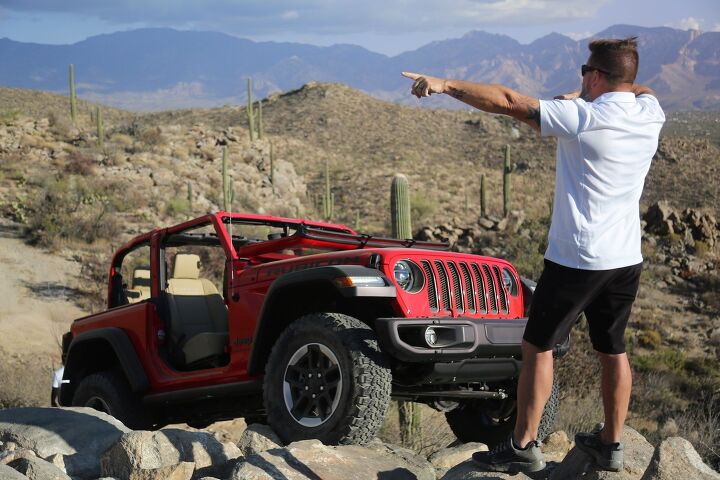
Picking up speed on a rutted out gravel trail also showed us the Wrangler’s willingness to soak up ruts and divots without punishing the occupants or being a handful to control.
For water crossings, Jeep says the JL will be able to handle up to 30 inches.
Accessories have always been a large part of the Wrangler’s business, and the majority of them are aimed at the off-road crowd. Mopar has already rolled out a massive catalog of parts with some of the headlines being a snorkel, hinge reinforcements for the swing gate for hanging a larger spare back there, tube frame doors, and many more. And probably the crowning achievement of Jeep’s accessories is the two-inch lift kit from Mopar, which when installed, can help the JL accommodate 35-inch tires with no other modifications necessary.
Pricing
If all of this sounds too good to be true, it’s not. It is too good to be cheap, though. The Wrangler is $3,000 more expensive across the board, with a basic two-door Sport model now costing $26,995. Go for a base two-door Rubicon and the price jumps to $36,995, while the base four-door Sport model sells for $30,495.
If you want a four-door Rubicon, before additional extras like an automatic transmission or turbocharged engine, you’ll be paying $40,495.

The Verdict: 2018 Jeep Wrangler JL Review and First Drive
Jeep did exactly what it needed to with the new Wrangler. It’s now easier to live with every single day for commuting and grocery duty, but in the process, it has been made even better off-road.
So if you’re looking to redesign an icon and keep the fans happy, the Jeep Wrangler JL is a perfect template for doing just that.
This article originally appeared on Off-Road.com
Discuss this article on our Jeep Wrangler Forum
LOVE IT
- Easy to control on road
- Unstoppable off-road
- Stock 33-inch tires
- Turbo power
LEAVE IT
- Loud interior

Stephen covers all of the day-to-day events of the industry as the News Editor at AutoGuide, along with being the AG truck expert. His truck knowledge comes from working long days on the woodlot with pickups and driving straight trucks professionally. When not at his desk, Steve can be found playing his bass or riding his snowmobile or Sea-Doo. Find Stephen on <A title="@Selmer07 on Twitter" href="http://www.twitter.com/selmer07">Twitter</A> and <A title="Stephen on Google+" href="http://plus.google.com/117833131531784822251?rel=author">Google+</A>
More by Stephen Elmer












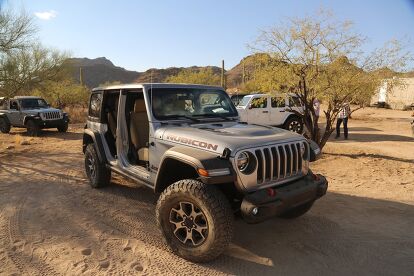



















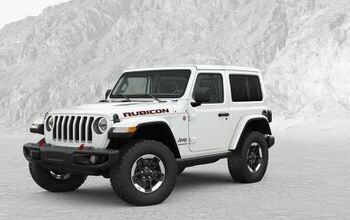




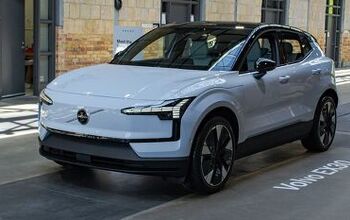



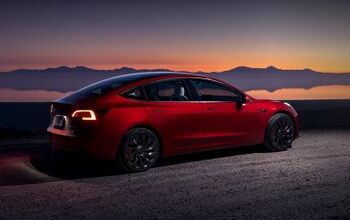
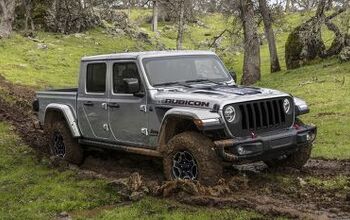


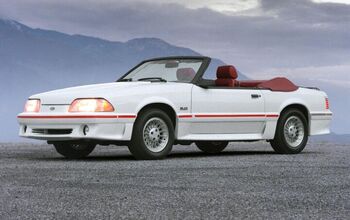

Comments
Join the conversation